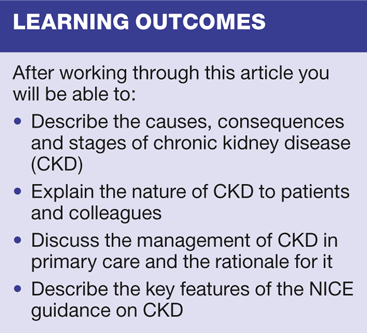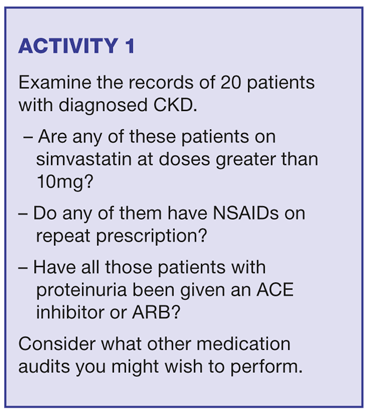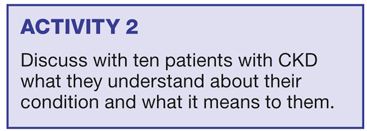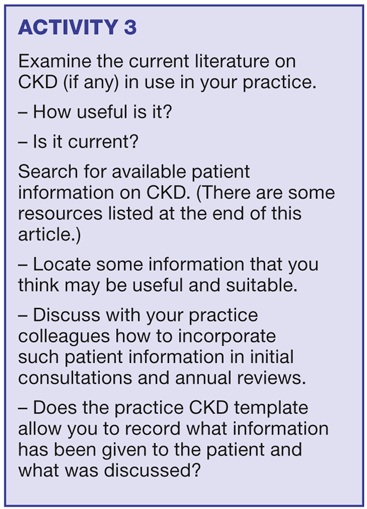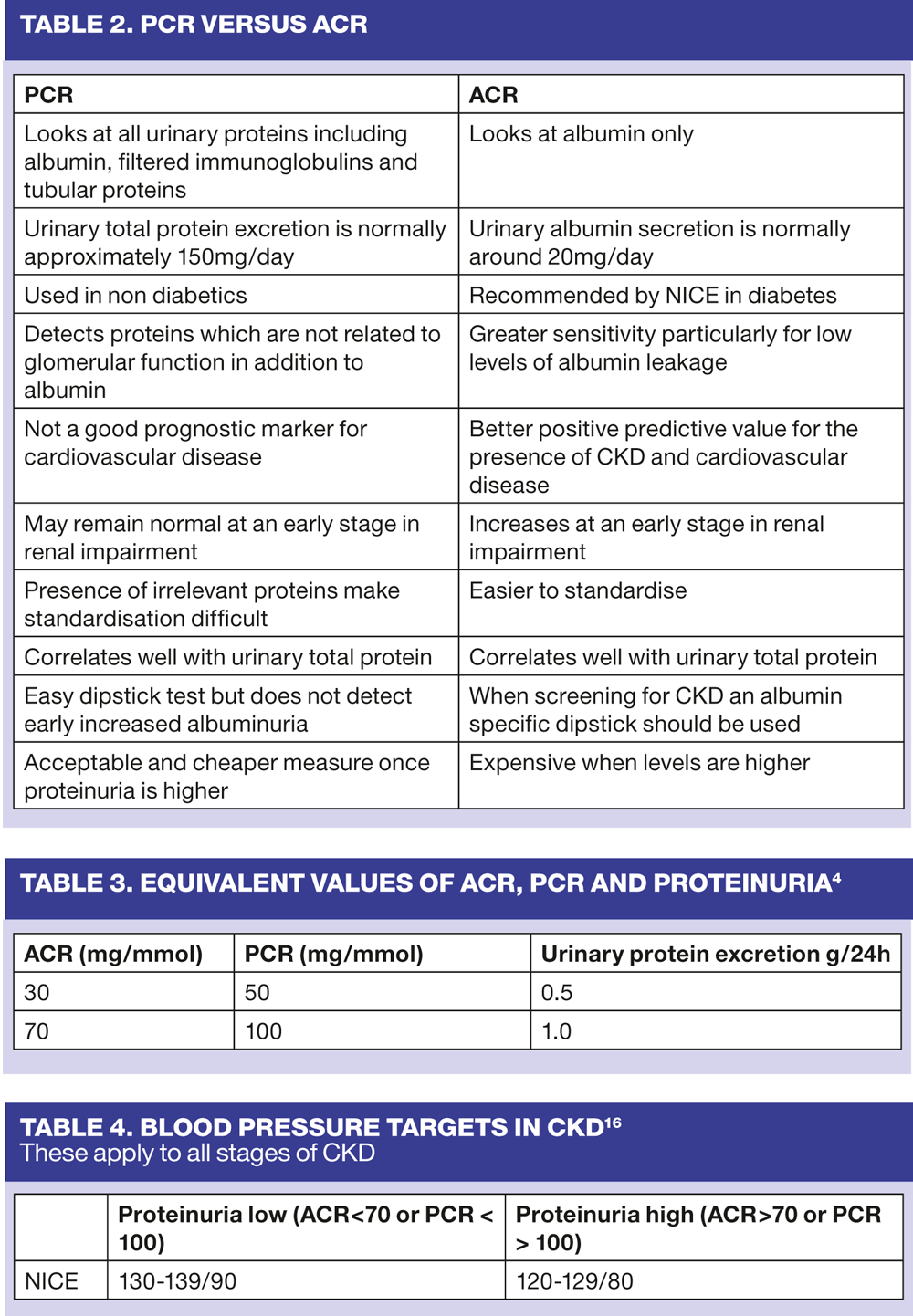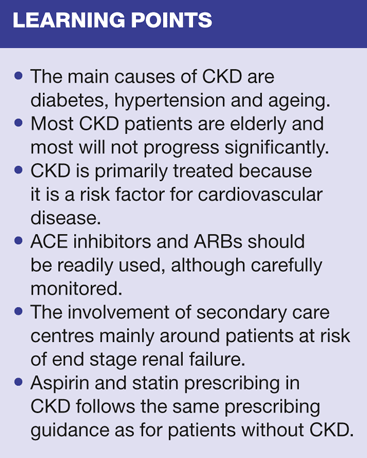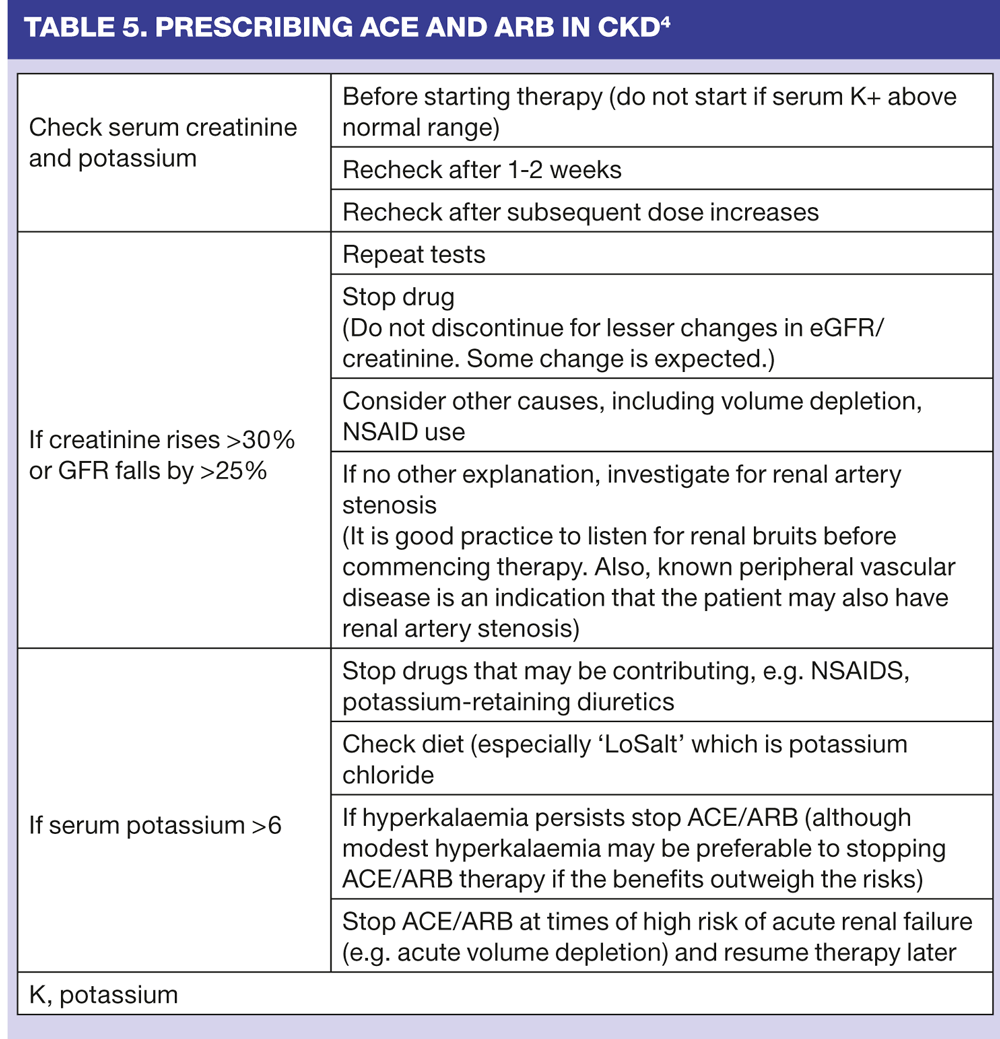Chronic kidney disease — an update
Dr Mary Lowth
Dr Mary Lowth
MAMB BChir FRCGP PGCME
GP Locum and MRCGP Examiner,
North London
Chronic kidney disease has become prominent in primary care in recent years, as we have gained understanding of its significance. What does this diagnosis mean to patients and health professionals?
The term chronic kidney disease (CKD) refers to long term, progressive loss of renal function.1 Kidney function gradually worsens over time, usually over a period of years, and at a variable rate. CKD is most commonly asymptomatic and is detected by screening at risk populations; a process which has accelerated in recent years as hospital laboratories began to report estimated glomerular filtration rate (eGFR) to GPs and CKD became a part of the Quality and Outcomes Framework (QOF). Although good medical management of CKD can slow progression, it is usually irreversible.
CKD is important for two, major reasons:
1. It flags up the presence of significant vascular disease, and is an independent risk factor for cardiovascular disease2
2. In some cases it can lead to complete failure of the kidneys, necessitating dialysis or transplantation.
For those patients whose CKD is progressing fast enough to reach a point of complete failure in their lifetime, early detection and successful medical management may slow disease progression and avert the eventual need for dialysis or transplantation.
This article discusses what a diagnosis of CKD means for patients and health professionals, its significance for the patient’s future health, and how best to manage it.
PREVALENCE, CAUSES AND RISK FACTORS
The average prevalence of CKD stages 1–5 has been reported at 11% in USA and Europe.3–5 The most common causes are diabetes, hypertension and ageing.3 Prevalence of CKD stages 3–5 (Table 1) was found to be 6% and varied with age; ranging from 1.5% aged 16–54 to 1 in 3 aged 75 and over. CKD stage 4–5 (estimated glomerular filtration rate [eGFR]<30) is rare. Only 1.5% of males and 1.3% of females reported being told by a doctor they had CKD, so clearly we have work to do.5
Diabetes
This is the commonest cause of end stage renal disease3 and is due to diabetic nephropathy, a small vessel disease paralleling retinopathy in its development. The prevalence of CKD stages 3-5 in adults with diabetes is estimated at 35%.6
Hypertension
Hypertension and atherosclerosis can cause CKD.1,7,8 However, CKD can also cause high blood pressure, due to the kidney’s role in blood pressure regulation. About 90% of people with CKD stages 3–5 (Table 1) have hypertension.
Ageing
There is an age-related decline in renal function. About half of people aged 75 or more have some degree of CKD as currently defined, and we are picking up both age related decline in renal function and CKD together.9 Some nephrologists worry that we are over diagnosing CKD in elderly patients2 as age related decline does not progress to renal failure. It does, however, carry the associated risks of cardiovascular disease, so there is arguably justification in including these patients in our registers.5
Other causes
Other conditions that can cause CKD include:
- Congestive cardiac failure
- Diseases of the glomeruli
- Renal artery stenosis (narrowing of the artery resulting in poor renal perfusion)
- Polycystic renal disease
- Obstructive uropathy
- Drug-induced and toxin-induced kidney damage
- Repeated kidney infections.
This list is by no means exhaustive; anything that can damage the kidneys can lead to CKD.
ADDITIONAL RISK FACTORS FOR CKD
Smoking
A history of smoking is a significant risk factor for CKD. More than 15 pack years of smoking increases the risk of CKD significantly.10
NSAIDS, ACE inhibitors and other nephrotoxic drugs11
NSAIDs, even in short courses, can cause acute renal failure due to renal underperfusion (they cause constriction and reduced flow in the afferent arteriole). NSAIDs may also cause acute renal failure due to interstitial nephritis, as well as analgesic nephropathy (chronic interstitial nephritis and papillary necrosis).
Analgesic nephropathy usually results from combination analgesic products that contain aspirin and/or paracetamol.5 It is one of the few preventable causes of chronic renal failure. Discontinuation of the abused drugs often results in stabilisation or even improvement in renal function but continued abuse leads to further renal damage.12
ACE inhibitors can also cause deterioration in renal function as they reduce constriction in the efferent arteriole. This is a particular problem if they are combined with an NSAID, especially in patients with compromised renal perfusion, or renal artery stenosis, as they may precipitate an acute deterioration in renal function.
Drugs that can cause direct renal damage include penicillamine, gold, captopril, phenytoin, some antibiotics, thiazide diuretics, furosemide, NSAIDs and rifampicin, aminoglycosides, amphotericin and ciclosporin. Lithium levels consistently above the therapeutic range have been associated with development of nephrogenic diabetes insipidus.
Obesity
There is no clear evidence that body mass index (BMI) is an independent risk factor for CKD.
Socioeconomic status
Some studies have suggested that low socioeconomic status is a risk factor for CKD.6,13,14
SCREENING
Based on these causes and risk factors SIGN1 and NICE4 recommend that all patients with diabetes and all individuals with hypertension on antihypertensive medication or on statin therapy should be screened at least annually for renal function.
NICE also recommends screening of those with renal stone disease, prostatic disease, known multisystem disease with potential for renal involvement, and those with a family history of CKD or an incidental finding of haematuria or proteinuria.4
DIAGNOSING AND DEFINING CKD
The diagnosis of CKD is based on the finding of raised serum creatinine,15 indicating reduced renal function. However a single raised creatinine level is not enough for initial diagnosis as creatinine is also raised in acute renal failure and in a few other conditions.
The eGFR (see below) is a means of standardising the creatinine measurement between patients, as creatinine also varies with patient size, age and gender. Further classification (Table 1) is then based on the presence or absence of protein and/or blood in the urine, either or both or which would suggest significant renal pathology.
Glomerular filtration rate (GFR)
Blood from the renal artery is carried to the kidneys where the vessels subdivide into multiple tiny networks of branched balls of vessels called glomeruli. The glomerulus is therefore the part of the kidney that ‘receives’ arterial blood for filtering. The rate at which this happens is measured in mls/minute. Normal GFR is 100ml/minute. However the GFR cannot be measured simply so we use an estimated GFR (eGFR) based on a calculation using the creatinine. The calculation uses age, ethnicity, gender and size (as an estimate of skin surface area) to estimate the GFR.
eGFR is measured in units of ml/min/1.73m2, because 1.73m2 represents one ‘standard’ body surface area. It therefore corrects for different sized patients and becomes a standard measure. It may be less reliable as an estimation of true GFR in pregnancy, oedematous states, muscle-wasting disorders, amputees and malnourished people, and has not been well validated in some ethnic groups (e.g. Asians and Chinese). It needs to be multiplied by 1.21 in persons of African or Afro-Caribbean heritage.
A normal eGFR level is usually taken to be above 90 ml/min/1.73m2.
CLASSIFICATION
CKD is classified via the eGFR.1,4 (Table 1)
To make the diagnosis, the eGFR readings must be taken on three consecutive occasions within a period of no less than 90 days.
eGFR
for 3 months
All such individuals are classified as having chronic kidney disease, irrespective of the presence or absence of kidney damage. This reduction in kidney function represents a loss of half or more of the adult level of normal kidney function.
Kidney damage
All individuals with kidney damage, e.g. trauma, tumour etc., are classified as having CKD, irrespective of the level of eGFR. Those with eGFR > 60 ml/min/1.73m2 are included because eGFR may be sustained at normal or increased levels despite substantial kidney damage but they nevertheless face the same risks as CKD patients with lowered eGFR. CKD is then further classified by the presence or absence of significant microalbuminuria, proteinuria or haematuria.
Proteinuria
Proteinuria is an independent marker for worsening of renal function and cardiovascular disease.
Albumin creatinine ratio (ACR)2 was chosen by NICE4 as the best method of assessing proteinuria in CKD (Table 2). Table 3 shows comparison between ACR, protein creatinine ratio(PCR) and the now obsolete total urinary protein measurements.
Significant proteinuria in non-diabetic kidney disease is defined as an ACR >30 mg/mmol. By way of comparison, microalbuminuria in people with diabetes is defined as an ACR >2.5 in men or >3.5 mg/mmol in women
If the ACR is between 30 and 70 mg/mmol, NICE recommends that the test be repeated on an early morning sample. If the ACR is >70 mg/mmol, there is no need to repeat.2
Dipsticks will detect proteinuria when the ACR is around 45mg/mmol so are not effective as a screening tool as they will miss early cases.2
CONSEQUENCES
CKD does not always have a vascular cause, but it rapidly becomes a vascular issue. As renal function decreases:
- BP increases due to fluid overload and production of vasoactive hormones created by the kidney increasing the chance of developing hypertension and congestive cardiac failure (CCF).
- CKD leads to accelerated atherosclerosis and patients are more likely to develop cardiovascular disease than the general population.
TREATMENT
The aim of treatment is to:
- Prevent or slow down progression towards renal failure.
- Reduce cardiovascular risk and therefore improve cardiovascular outcomes.
Reducing the risk of cardiovascular disease
Blood pressure control
People with CKD have an increased risk of developing cardiovascular disease and are actually twenty times more likely to die from cardiovascular-related problems than from kidney failure.15 Most people with CKD require medication to control their blood pressure. Blood pressure targets are given in Table 4.16
Statins
Statins are usually indicated. NICE concluded that there is insufficient evidence that statins independently slow the progression of CKD, but that the decision to prescribe them should be made using the existing cardiovascular ten year risk tables in the usual way – i.e. the decision making process for starting statins is the same for patients with and without CKD.
Antiplatelet therapy
People with CKD are at increased risk of minor bleeding, probably due to impairment in platelet function17 and NICE suggests that use of aspirin or other antiplatelet drugs is restricted to those who need secondary prevention of cardiovascular disease.4
ACE inhibitors and ARBs
ACE inhibitors or ARBs can cause deterioration in renal function and must be carefully monitored. Nevertheless, they have a protective effect on the kidney and improve cardiovascular outcomes. As long as they do not cause marked deterioration in renal function they should be prescribed in all cases of CKD with proteinuria. More specific guidance around the prescribing of these drugs is given in Table 5.
Lifestyle factors
As patients with CKD are more likely to die from a cardiovascular event than their CKD these measures to reduce cardiovascular risk profile are important:
- Smoking cessation
- Alcohol reduction to within safe limits
- Optimal diet, including a low salt intake
- Weight management
- Regular physical activity – aiming for 2.5 hours a week undertaken on at least three separate occasions.
Medication review
This is aimed at:
1. Replacing medications which may worsen renal function e.g.
- metformin is stopped at stage 4
- simvastatin is used with caution at doses above 10mg in stage 4 (manufacturer advises avoid >10mg)18
- lercanidipine needs to be stopped at stage 4.18
2. Reducing doses of medications which are excreted by the kidneys and for which slowed excretion means a lower doses is needed
3. Adding protective medications that may benefit the kidneys. This is true of all CKD patients with significant proteinuria, who should be on an ACE inhibitor or ARB. This both lowers cardiovascular risk and slows CKD progression.
Improved diabetic control
The achievement of good diabetic control is beneficial for CKD, although in patients with longstanding diabetes overly tight control may actually be harmful - as seen in the ACCORD trial – and may also increase risk of hypos. HbA1C targets should be considered carefully with this in mind.19
Relieving symptoms and problems caused by CKD
If CKD becomes severe patients may need specific treatment:
- Treatment for anaemia with iron or erythropoietin - a hormone normally made by the kidneys
- Close control of fluid and salt intake
- Dietary restriction to control raised calcium and potassium levels
- End stage renal failure will need peritoneal or haemodialysis, and/or transplant.
Immunisations
People with stage 3 CKD or worse should be immunised against influenza each year, and have a one-off immunisation against pneumococcus. Their immunity is impaired and they are therefore at greater risk of complications. People with stage 4 CKD should be immunised against hepatitis B, because they may need dialysis in the future and may therefore be exposed to hepatitis B.
PROGNOSIS
Stages 1-3 CKD are common, especially in older people. The rate of progression varies with underlying conditions but is usually slow with very few progressing to stage 5 (end stage renal disease). However, being told that ‘your kidneys are not working as well as they should’ or that you have a ‘bit of kidney failure’ will be alarming for patients. In common with other long-term conditions, their successful management will rely on their cooperation and understanding if medication and life-style advice is to be adhered to. The principle of long-term condition management – for the patient to be the major partner in their management – applies to CKD as it does to other conditions.
An outline guide to explaining CKD to patients is given in Box 1.
REFERRAL
Referral to secondary care is mainly to allow advance planning for renal replacement, so it is essentially aimed at patients who may reach end stage renal disease. NICE guidance is currently that patients should be referred into secondary care in the following circumstances:
- Stage 4 and 5 CKD (with or without diabetes)
- Higher levels of proteinuria (ACR ≥ 70 mg/mmol) unless known to be due to diabetes and already appropriately treated
- Proteinuria (ACR ≥ 30 mg/mmol) together with haematuria
- Rapidly declining eGFR (>5 ml/min/1.73m2 in 1 year, or > 10 ml/min/1.73m2 within 5 years)
- Hypertension that remains poorly controlled despite the use of at least four antihypertensive drugs at optimal therapeutic doses
- People with, or suspected of having, rare or genetic causes of CKD
- Suspected renal artery stenosis.
CKD and renal outflow obstruction merits referral to urological services.
CONCLUSION
CKD is common, particularly in patients with diabetes and hypertension, and patients are at high risk of cardiovascular events. Aggressive interventions to improve cardiovascular risk are warranted. Lifestyle factors are important in this; particularly smoking cessation, exercise and reducing salt intake.
Practice nurses are likely to see these patients frequently and should take every opportunity to promote their health and understanding of their condition, to enable them to work in partnership with their health care providers.
SELF-ASSESSMENT QUESTIONS
1. List 5 causes of CKD.
2. Who should be screened for CKD?
3. Which CKD patients should be on:
a) aspirin
b) a statin?
4. Why are ACE inhibitors prescribed when there is a caution around their use in renal failure?
5. What is the difference between GFR and eGFR
eGFR is simple an estimate of GFR, calculated from the creatinine level
6. What are the treatment aims in CKD?
7. Which patients should be referred to secondary care in CKD?
8. What is the significance of proteinuria in CKD and how is it managed?
9. What lifestyle advice is important in CKD?
10. Are patients with only one kidney more likely to get CKD?
SELF-ASSESSMENT ANSWERS
1. Five from: diabetes, hypertension, ageing – these are the main causes – other renal diseases, congestive cardiac failure and atherosclerosis.
2. NICE recommend screening of all patients at increased risk which means patients with diabetes, patients on treatment for hypertension and patients with known renal disease, family history of CKD, incidental haematuria or proteinurea, or systemic diseases likely to affect the kidney. Specifically, age alone is not a risk marker for testing.
3. These drugs should be prescribed in accordance with the cardiovascular risk tables for people with and without diabetes. The presence or absence of CKD is not at present considered to adjust that risk.
4. ACE inhibitors or ARBs have a protective effect on the kidney and improve cardiovascular outcomes. As long as they do not cause marked deterioration in renal function they should be prescribed in all cases of CKD with proteinuria.
5. eGFR is an estimate of GFR, calculated from the creatinine level and using age, ethnicity and size to calculate a near guess at the GFR. GFR is measured in mL/min. eGFR is measured in units of mL/min/1.73m2 – one ‘standard body surface area.
6. Reduction of cardiovascular risk - through good blood pressure control, good diabetes control, and appropriate prescribing of statins and antiplatelet therapy - and slowing of progression of renal disease.
7. Those with stage 4 and 5 CKD, those showing signs suggesting more severe renal disease or more rapid progression. In other words all those who may possibly be at risk of reaching the point of end stage renal disease in their lifetime.
8. Proteinuria signifies glomerular damage. It is an independent marker of worsening renal function and cardiovascular disease.
9. Smoking cessation, modification of alcohol intake where necessary, regular exercise, healthy diet, salt reduction. If more severe renal disease develops then restriction of potassium, calcium and fluids may become necessary.
10. This is a trick question and not in the article! Well done if your response was to look it up. Patients with only one kidney – whether congenitally, transplanted post renal failure or because they have lost or donated one - tend to have a larger single kidney to compensate for the absence of the other. This may well be functioning perfectly well but their creatinine will be typically slightly raised, simply because they have fewer working glomeruli than if they had two kidneys. However, this does not mean they have progressive renal disease, or CKD. They are one of the groups for whom the eGFR could be misleading if the full circumstances were not understood.
REFERENCES
1. Scottish Intercollegiate Guidelines Network (SIGN): Diagnosis and management of chronic kidney disease. 2008 http://www.sign.ac.uk/Guidelines/fulltext/103/index.html
2. Lewis R. Diagnosing and monitoring CKD in practice. Prim Care Cardiovasc J 2009 Special issue; Chronic Kidney Disease: 8-10
3.United States Renal Data System. Annual data report 2012 http://www.usrds.org/.
4. National Institute for Health and Clinical Excellence (NICE).Chronic kidney disease: early identification and management of chronic kidney disease in adults in primary and secondary care. Clinical guideline 73. 2008 http://guidance.nice.org.uk/CG73/NICEGuidance/pdf/English
5. Health Services Research and clinical issues: Prevalence of chronic kidney disease in England: Findings from the 2009 Health Survey for England J Epidemiol Community Health 2011;65:Suppl 2 A12
6. National Chronic Kidney Disease Factsheet 2010 : http://www.cdc.gov/diabetes/pubs/factsheets/kidney.htm
7. Fox CS, Larson MG, Leip EP, et al. Predictors of new-onset kidney disease in a community-based population. JAMA 2004; 291(7):844-50.
8. Foley RN, Murray AM, Li S, et al. Chronic kidney disease and the risk for cardiovascular disease, renal replacement, and death in the United States Medicare population, 1998-1999. J Am Soc Nephrol 2005;16(2):489-95.
9. O’Hare AM, Bertenthal D, Covinsky KE, et al. Mortality risk stratification in chronic kidney disease: one size for all ages? J Am Soc Nephrol 2006;17(3):846-53.
10. Yacoub R, Habib H, Lahdo A et al. Association between smoking and chronic kidney disease: a case control study. BMC Public Health 2010, 10:731 doi:10.1186/1471-2458-10-731 http://www.biomedcentral.com/1471-2458/10/731/prepub
11. Prescribing in renal impairment: Patient.co.uk: http://www.patient.co.uk/doctor/Drug-Prescribing-in-Renal-Impairment.htm
12. Curhan GC, Knight EL, Rosner B, Hankinson SE, Stampfer MJ. Lifetime
nonnarcotic analgesic use and decline in renal function in women. Arch
Intern Med 2004;164(14):1519-24.
13. Merkin SS, Coresh J, Diez Roux AV, Taylor HA. Powe NR. Area socioeconomic status and progressive CKD: the atherosclerosis risk in communities (ARIC) study. Am J Kidney Dis 2005; 46(2): 203-213
14. Bello AK, Peters J, Rigby J, Rahman AA, El Nahas M. Socioeconomic status and chronic kidney disease at presentation to a renal service in the United Kingdom. CJASN 2008; 3(5): 1316-1323 cjasn.asnjournals.org/content/3/5/1316.abstract
15. Lab tests online http://www.labtestsonline.org.uk/understanding/analytes/creatinine/tab/test
16. The Renal Association. Hypertension: Blood pressure targets in renal disease: http://www.renal.org/whatwedo/InformationResources/CKDeGUIDE/Hypertension.aspx
17. Platelet dysfunction in uremia Berns J, Coutre S Wolters Klewer Health Up-To-Date website: http://www.uptodate.com/contents/platelet-dysfunction-in-uremia
18. British National Formulary online : www.bnf.org
19. The Action to Control Cardiovascular Risk in Diabetes (ACCORD) Study Group. Effects of intensive glucose lowering in Type 2 diabetes. NEJM 2008;358:2545-2559 http://www.nejm.org/doi/full/10.1056/NEJMoa0802743
Related articles
View all Articles

